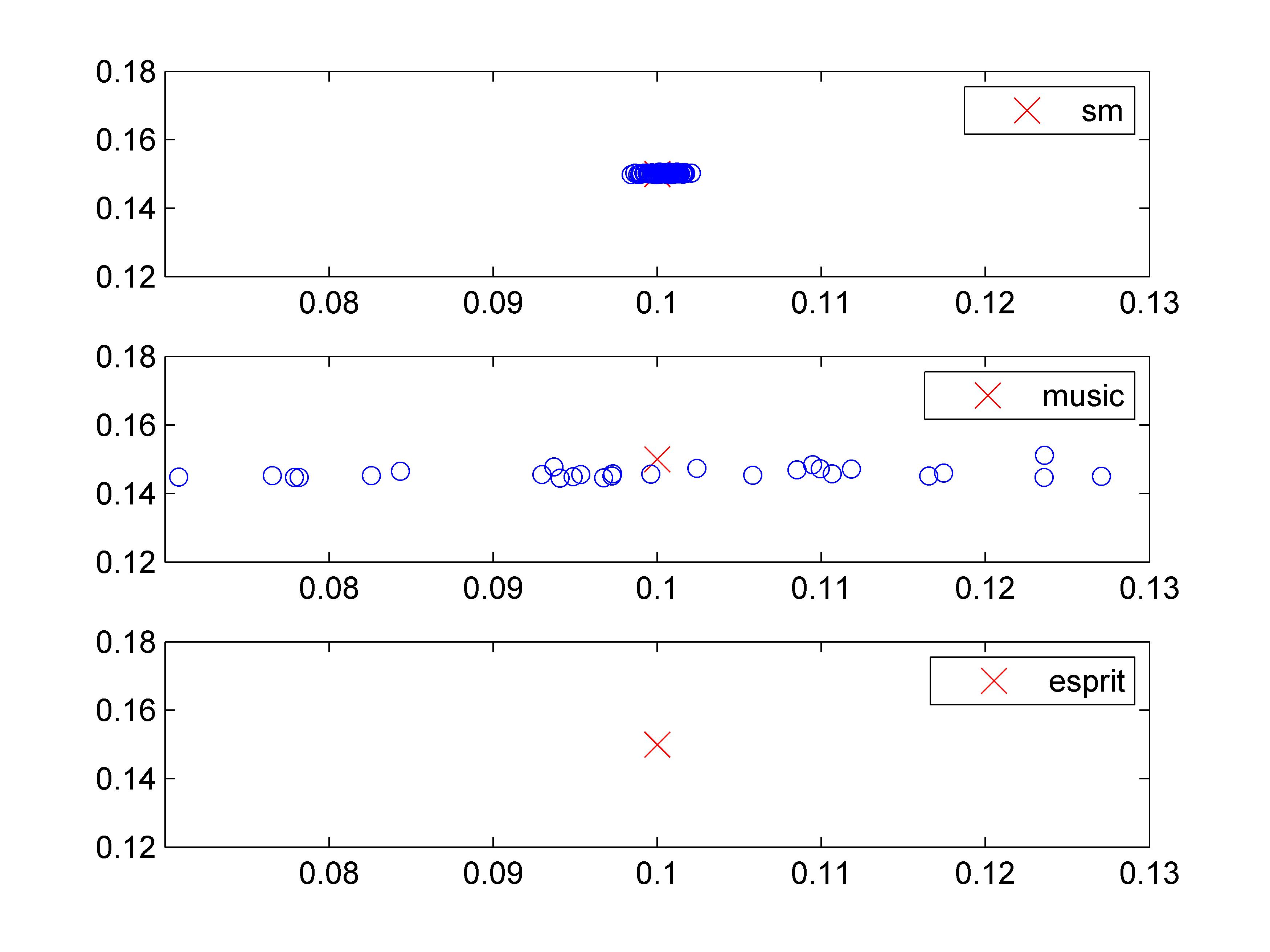% demo: scatter plots comparing sm with music and esprit % it shows that the variance of the sm-estimates is % superior to the other two. % % simulation example from sesha2 page 38 % Setting up the signal parameters and time interval % here y=unit variance white noise + .5*sin(.1*t+phi1) + sin(.15*t+phi2) clear, close all N=1000; mag0=.35; mag1=.5; o1=.1; mag2=1; o2=.15; t=0:N-1; t=t(:); % drawing the target frequency1 vs frequency2 for the subsequently generated % scatter diagrams figure(1), clf, subplot(3,1,1), plot(o1,o2,'rx','MarkerSize',12), hold on, subplot(3,1,2), plot(o1,o2,'rx','MarkerSize',12), hold on, subplot(3,1,3), plot(o1,o2,'rx','MarkerSize',12), hold on, % simulating the time series and determining the frequencies of the two % sinusoids. IS_count=0; MUSIC_count=0; ESPRIT_count=0; for i=1:100, y=mag0*randn(N,1)+mag1*sin(o1*t+2*pi*rand)+mag2*sin(o2*t+2*pi*rand); % estimating sinusoids per music, esprit n=4; m=30; omusic=music(y,n,m); omusic=omusic(omusic>=0); omusic=sort(omusic); omusic=omusic(end-1:end); oesprit=esprit(y,n,m); oesprit=oesprit(oesprit>=0); oesprit=sort(oesprit); oesprit=oesprit(end-1:end); % IS-based estimation thetamid=.05; [Ah,bh]=cjordan([30],[0.4*exp(thetamid*j)]); P=dlsim_complex(Ah,bh,y'); [omega_ss,residues_ss]=sm(P,Ah,bh,n); omega_ss=omega_ss(omega_ss<pi); omega_ss=sort(omega_ss);omega_ss=omega_ss(end-1:end); if(omega_ss(1)>0.07&&omega_ss(1)<0.13&&omega_ss(2)>0.12&&omega_ss(2)<0.18) IS_count=IS_count+1; end if(omusic(1)>0.07&&omusic(1)<0.13&&omusic(2)>0.12&&omusic(2)<0.18) MUSIC_count=MUSIC_count+1; end if(oesprit(1)>0.07&&oesprit(1)<0.13&&oesprit(2)>0.12&&oesprit(2)<0.18) ESPRIT_count=ESPRIT_count+1; end % [omega_ss,omusic oesprit]; subplot(3,1,1), plot(omega_ss(1),omega_ss(2),'o'), subplot(3,1,2), plot(omusic(1),omusic(2),'o'), subplot(3,1,3), plot(oesprit(1),oesprit(2),'o'), end figure(1), subplot(3,1,1), axis([.07 .13 .12 .18]); hold on, legend('sm') subplot(3,1,2), axis([.07 .13 .12 .18]); hold on, legend('music') subplot(3,1,3), axis([.07 .13 .12 .18]); hold on, legend('esprit')
Comparison with MUSIC and ESPRIT
We compare the state-covariance-based high resolution tools with the MUSIC and ESPRIT methods for spectral line detection. We consider a real-valued time series which is an additive
composition of  sinusoids with white noise. The length of observation record is
sinusoids with white noise. The length of observation record is  , and
, and

where  ,
,  and
and  ,
,  . The noise is white, Gaussian, with standard deviation
. The noise is white, Gaussian, with standard deviation  . For each observation record, we estimate spectral lines
using MUSIC, ESPRIT and the state-covariance-based methods. We compare the results from
. For each observation record, we estimate spectral lines
using MUSIC, ESPRIT and the state-covariance-based methods. We compare the results from  runs.
runs.
We display below the scatter plots of the estimated  v.s.
v.s.  .
The red cross marks the target frequencies. We choose a small window containing the target and if there is point detected inside the box, we claim a detection.
There are totally
.
The red cross marks the target frequencies. We choose a small window containing the target and if there is point detected inside the box, we claim a detection.
There are totally  detections for the state-covariance-based method (100% success) and
detections for the state-covariance-based method (100% success) and  detections for the MUSIC method, and none for the ESPRIT method.
We also see that the results given by the state-covariance-based method are very concentrated around the target point.
detections for the MUSIC method, and none for the ESPRIT method.
We also see that the results given by the state-covariance-based method are very concentrated around the target point.
 |